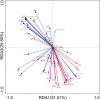Effect of biochar on antibiotics and antibiotic resistance genes variations during co-composting of pig manure and corn straw
- PMID: 35979171
- PMCID: PMC9377313
- DOI: 10.3389/fbioe.2022.960476
Effect of biochar on antibiotics and antibiotic resistance genes variations during co-composting of pig manure and corn straw
Abstract
Pig manure is a reservoir of antibiotics and antibiotic resistance genes (ARGs). The effect of biochar on the variations in physicochemical properties, bacterial communities, antibiotics, ARGs, and mobile genetic elements (MGEs) of compost product during co-composting of pig manure and corn straw have been investigated in this study. Compared with the control treatment (CK), biochar addition accelerated the increase in pile temperature and prolonged the high temperature period (>55°C) for 2 days. Under biochar influence, organic matter degradation, NH4 +-N conversion and NO3 --N production was accelerated, and dissolved total organic carbon (DOC) and dissolved total nitrogen (DTN) utilization by microorganisms were enhanced. Biochar addition altered the microbial community and promoted the vital activity of Actinobacteria in the later composting stage. The antibiotics removal efficiency (except danofloxacin and enrofloxacin) was accelerated in the early composting stage (1-14 days) by biochar addition, the pile temperature had a positive effect on antibiotics removal, and the total antibiotics removal efficiency in CK and CK+Biochar treatments was 69.58% and 78.67% at the end of the composting process, respectively. The absolute abundance of most of the ARGs in the CK+Biochar treatment was lower than that in the CK treatment during composting, and the ARGs removal mainly occurred in the early (1-14 days) and later (28-50 days) stages. Biochar addition reduced the absolute abundance of MGEs (intI1, intI2) in the compost product, and most of the ARGs had a significant positive correlation with MGEs. Network analysis and redundancy analysis showed that ARGs and MGEs occurred in various host bacteria (Firmicutes, Actinobacteria, Bacteroidetes, Proteobacteria, and Halanaerobiaeota), and that DTN and NH4 +-N are the main factors regulating the changes in bacterial communities, antibiotics, ARGs, and MGEs during composting. Moreover, MGEs contributed the most to the variation in ARGs. In summary, biochar addition during composting accelerated antibiotics removal and inhibited accumulation and transmission of ARGs. The results of this study could provide theoretical and technical support for biochar application for antibiotics and ARGs removal during livestock and poultry manure composting.
Keywords: antibiotic resistance genes; antibiotics; biochar; compost; mobile genetic elements.
Copyright © 2022 Tong, Liu, Tian, Zhang, Liu, Duan, Bi, Qin and Xu.
Conflict of interest statement
The authors declare that the research was conducted in the absence of any commercial or financial relationships that could be construed as a potential conflict of interest.
Figures








Similar articles
-
Effects of adding corn straw and apple tree branches on antibiotic resistance genes removal during sheep manure composting.J Environ Manage. 2024 Nov;370:122910. doi: 10.1016/j.jenvman.2024.122910. Epub 2024 Oct 15. J Environ Manage. 2024. PMID: 39405860
-
[Dynamic Changes in Antibiotic Resistance Genes During Biological Fermentation of Chicken Manure and Pig Manure].Huan Jing Ke Xue. 2023 Mar 8;44(3):1780-1791. doi: 10.13227/j.hjkx.202204215. Huan Jing Ke Xue. 2023. PMID: 36922238 Chinese.
-
Dynamics of antibiotic resistance genes and the association with bacterial community during pig manure composting with chitin and glucosamine addition.Front Microbiol. 2024 May 22;15:1384577. doi: 10.3389/fmicb.2024.1384577. eCollection 2024. Front Microbiol. 2024. PMID: 38841060 Free PMC article.
-
Key factors driving the fate of antibiotic resistance genes and controlling strategies during aerobic composting of animal manure: A review.Sci Total Environ. 2021 Oct 15;791:148372. doi: 10.1016/j.scitotenv.2021.148372. Epub 2021 Jun 8. Sci Total Environ. 2021. PMID: 34139488 Review.
-
Proliferation of antibiotic-resistant microorganisms and associated genes during composting: An overview of the potential impacts on public health, management and future.Sci Total Environ. 2021 Aug 25;784:147191. doi: 10.1016/j.scitotenv.2021.147191. Epub 2021 Apr 19. Sci Total Environ. 2021. PMID: 33905939 Review.
Cited by
-
Application of compost amended with biochar on the distribution of antibiotic resistance genes in a soil-cucumber system-from the perspective of high-dose fertilization.Front Microbiol. 2025 Mar 10;16:1530296. doi: 10.3389/fmicb.2025.1530296. eCollection 2025. Front Microbiol. 2025. PMID: 40130237 Free PMC article.
-
The Role of the Environment (Water, Air, Soil) in the Emergence and Dissemination of Antimicrobial Resistance: A One Health Perspective.Antibiotics (Basel). 2025 Jul 29;14(8):764. doi: 10.3390/antibiotics14080764. Antibiotics (Basel). 2025. PMID: 40867959 Free PMC article. Review.
-
Thermophilic microbial agents promote the fermentation progression of spent mushroom compost and pig manure.Front Microbiol. 2025 Jun 18;16:1575397. doi: 10.3389/fmicb.2025.1575397. eCollection 2025. Front Microbiol. 2025. PMID: 40606176 Free PMC article.
-
Humus Soil Inhibits Antibiotic Resistance Gene Rebound in Swine Manure Composting by Modulating Microecological Niches.Microorganisms. 2025 Mar 3;13(3):571. doi: 10.3390/microorganisms13030571. Microorganisms. 2025. PMID: 40142464 Free PMC article.
-
A Review on the Degradation of Antibiotic Resistance Genes During Composting of Livestock Manure.Toxics. 2025 Aug 8;13(8):667. doi: 10.3390/toxics13080667. Toxics. 2025. PMID: 40863943 Free PMC article. Review.
References
-
- Alexandrino D. A. M., Mucha A. P., Almeida C. M. R., Gao W., Jia Z., Carvalho M. F., et al. (2017). Biodegradation of the veterinary antibiotics enrofloxacin and ceftiofur and associated microbial community dynamics. Sci. Total Environ. 581-582, 359–368. 10.1016/j.scitotenv.2016.12.141 - DOI - PubMed
-
- Awasthi M. K., Wang Q., Chen H., Wang M., Ren X., Zhao J., et al. (2017). Evaluation of biochar amended biosolids co-composting to improve the nutrient transformation and its correlation as a function for the production of nutrient-rich compost. Bioresour. Technol. 237, 156–166. 10.1016/j.biortech.2017.01.044 - DOI - PubMed
LinkOut - more resources
Full Text Sources
Research Materials

